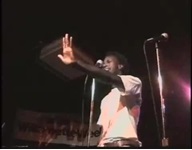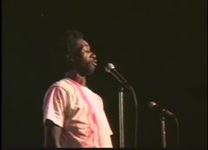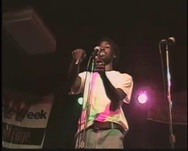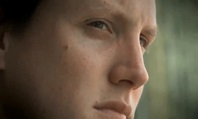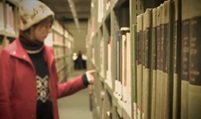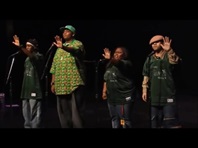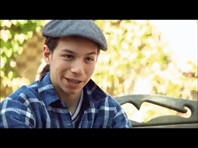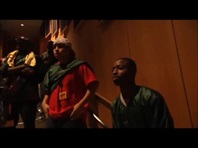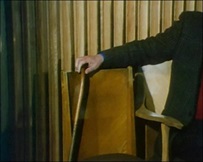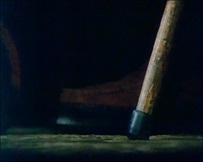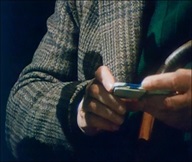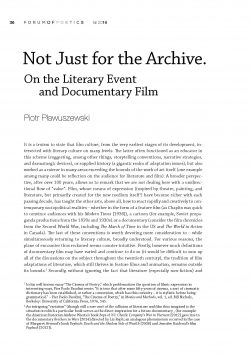
It is a truism to state that film culture, from the very earliest stages of its development, intersected with literary culture on many levels. The latter often functioned as an educator in this scheme (suggesting, among other things, storytelling conventions, narrative strategies, and dramaturgic devices), or supplied history (a gigantic realm of adaptation issues), but also worked as a mirror in many areas exceeding the bounds of the work of art itself (one example among many could be reflection on the audience for literature and film). A broader perspective, after over 100 years, allows us to remark that we are not dealing here with a unidirectional flow of “value”. Film, whose means of expression (inspired by theatre, painting, and literature, but primarily created for the new medium itself[1]) have become richer with each passing decade, has taught the other arts, above all, how to react rapidly and creatively to contemporary sociopolitical realities – whether in the form of a feature film (as Chaplin was quick to convince audiences with his Modern Times [1936]), a cartoon (for example, Soviet propaganda productions from the 1920s and 1930s).or a documentary (consider the film chronicles from the Second World War, including The March of Time in the US and The World in Action in Canada). The last of these conventions is worth devoting more consideration to – while simultaneously returning to literary culture, broadly understood. For various reasons, the plane of encounter thus reckoned seems counter-intuitive. Firstly, however much definitions of documentary film may have varied and continue to do so (it would be difficult to sum up all of the discussions on the subject throughout the twentieth century), the tradition of film adaptations of literature, which still thrives in feature films and animation, remains outside its bounds.[2] Secondly, without ignoring the fact that literature (especially non-fiction) and the cinema of facts have, over the decades, reached some points of shared inspiration, it is nonetheless necessary to underscore the independent nature of documentary film’s development as a form, compared to features. In Jack Ellis’s words: “Documentary, then, as an artistic form, is a technique and style that originated in motion pictures”[3] (at the same time, he then adds, the achievements of nineteenth-century photography constitute another important component of its history, one that cannot be marginalized). Thirdly, where the phenomenon of books that arise from previously existing feature films (novelizations[4]) is familiar, factographic films undergo such transformations considerably less often (one Polish exception that confirms the rule is Henryk Grunberg’s Dziedzictwo [The Legacy, 1993], which followed in the wake of Paweł Łoziński’s documentary masterpiece Miejsce urodzenia [Place of Birth, 1992]). The question then arises, where we are more likely to find the point of encounter, mentioned arlier, of literary culture and documentary film. The thought comes to mind that we should here highlight the indispensable (though not always actualized) function of the latter, which is – documenting or recording unscripted reality.[5] And yet exactly that kind of reality is vouchsafed to us as well by certain manifestations of literary culture, for example those that are “unrepeatable” in the particular form of a certain event or set of events. A poetry slam or a meeting with an author – these are precisely that kind of “event,” clearly very different from each other, but also promoting us, within the framework of the problem under discussion, to outline certain analogies. Let them be illuminated by the more general thought (to be explicated in the course of our reflections) that a documentary film– if only the intention behind it is not limited to the desire for ordinary “archiving” of reality – can effectively transcend the role of a mere addition to an event in order to become, on the contrary, its careful interpreter.
At the beginning, we have the form of the poetry slam that developed in the 1980s: “the first poetry event that combined the elements of performance, writing, competition and audience-participation.”[6] The hybrid nature of the slam, the dynamic of both human collectivity and each instance of performance before the group by a particular person, the dramaturgy inscribed in the formula of the competition (not to mention the potential literary value of the work presented there) – all undoubtedly present intriguing material for the documentary film camera. Significantly, that camera might, in accompanying the poet-contestants, transcend its role of simply being a recorder-archivist. This was demonstrated by Paul Devlin in his documentary SlamNation [1998], a full-length film about the National Poetry Slam (Portland, Oregon 1996), a festival several days long in which participants gather from all over the United States. Leaving aside the “humane” value of the film (competing in slams does not rule out respect for rival poets), there are three matters worth considering: (1) the use of multiple cameras allows viewers to keep up, via montage, with the spoken word performance (and the director manages to convey the speed of the performance through faster cutting); (2) it is the documentary film that succeeds at moments in capturing one of the most important aspects of the poetry slam, its rather free relationship to the written text. Roger Ebert noted the importance of one shot in connection with this realization in his review of SlamNation: “Slams are essentially performance art, not literary art, and there is a shot of a New York book editor, sighing at his stack of slam manuscripts and observing that sometimes the poems don’t translate well to the printed page”[7]; (3) a film like SlamNation, particularly the sequences featuring performances by poet-contestants, is able to minimalize (if not repair) the loss situationally inherent in a poetry slam’s reception when that reception is mediated – the viewer, naturally having the awareness of a “constructed view” (through the choice of lens, camera angle, montage, and so on) is then closer to many important qualities of the event than he or she would be in dealing with an audio recording. On the non-transferable value of the visual element in experiencing a poetry slam, Susan B. A. Somers-Willett has written: “Slam poetry’s following has been gained not merely through the act of listening; although CDs and MP3s are a popular way of documenting slam poetry, such verse is created to be best understood in live performance. (…) Audiences don’t merely listen to a poem; they react to an entire performance of verse, at times performing right back through applause, spiteful hissing, or comments shouted to the poet or slam host. Audiences receive performed verse by experiencing how the poet moves, appears, sounds, and physically embodies the poem.”[8]
(from SlamNation, directed by P. Devlin)
Filmed recordings of poetry slams (but also of the “literary event” of a public meeting with an author, to be discussed in a moment) elicit fundamental questions about the status of audiovisual material. For example: woven into the in the fabric of Kordian Piwowarski’s 2013 film Baczyński, joining together various conventions of presentation, are shots from a poetry slam organized in Warsaw in 2011, to mark the 90th birthday of the eponymous poet, at which the participants presented his poetry to the audience. It is certainly an important element in the film, since in a subtle way it allows viewers to ponder whether (to cite words spoken to the audience from the stage) “this poetry still lives today, whether it speaks to you in some way.” For this text, however, what is more crucial is the question of how and whether that recording of a Warsaw slam could function outside of Kordian Piwowarski’s Baczyński as an autonomous film – as something more than “purely archival footage, in which the point is simply to have the most basic record of the laying-on of the winner’s wreath or his handshake with a dignitary.”[9] That is a very complex question, particularly in the context of the many different aspects of the material in factographic film. For the purposes of this text, let us stick with the valuable observation (far removed though it be from simple guidelines) of Kazimierz Karabasz: “If [documentary footage – PP] is not to be a casual notation of facts, they must have at least two qualities: they must be professionally photographed (composition, angles) and have their own kind of ‘inner energy.’ The first quality is obvious, but the second? You have to observe a person (people)’s behavior very carefully during the shot. When their inner energy is ‘charged’? It’s a question of your sense of the temperature of the event taking place… The camera operator may want to turn off the camera too soon– the director has to be vigilant (and keep the camera from being switched off). Of course they can take another shot. But it will already be a different moment. About something else”[10] – there is also, of course, the montage phase, when the material gathered “must now finally be given some kind of shape.”[11] Taking all of this into account, it is possible to imagine that the poetry slam parts of Baczyński – with their careful surveys of faces (and the emotions visible on them), differentiated by the perspectives through which they are seen, a colour scheme limited to black and white, precise convergence of soundtrack and image – could exist as a separate documentary film. A film restricting its represented world to the place of poetic rivalry, and only there seeking justification for its form and evoked meaning. An example of a work constructed in this way is the shot film Poetry Slam (2005, directed by Jordi Ortega), shot in Los Angeles. At the same time, it should be underscored that a much more frequent practice consists of the recorded poetry slam event becoming a part of a greater whole, which also includes, for example, interviews with subjects speaking directly to the camera or scenes from the protagonists’ everyday life (such a broadly conceived horizon is provided to viewers in the German documentary Dichter und Kämpfer: Das Leben als Poetryslammer in Deutschland [2012, dir. Marion Hütter], and the highly intriguing film by American directors Greg Jacobs and Jon Siskel, Louder Than a Bomb [2010], which highlights the therapeutic dimension of spoken-word poetry, to name two examples).
(Frames from Dichter und Kämpfer: Das Leben als Poetryslammer in Deutschland by M. Hütter)
(Frames from the film Louder Than a Bomb by G. Jacobs and J. Siskel)
Irrespective of the form taken by the encounter between poetry slam and documentary film, that encounter is a fact worthy of scholarly reflection, one often artistically intriguing and rich in meaning. Another event from the space of literary culture with, it would seem, similar potential in collision with the documentary camera, is the public meeting with an author: at book fairs, in connection with the publication of a new book, at a literary festival, or elsewhere. “It would seem” because this potential we sense has never – at least in Polish filmmaking, with which the author of the present work is most familiar – been fully exploited.
Firstly, many issues come up here that already required our attention in the context of the poetry slam. One of them is the nature of the recorded material – in an age of widely accessible digital recording it comes as no surprise that for about a decade almost every literary festival has to some degree kept audiovisual documentation of its proceedings. Public meetings with authors that take place at such festivals are no exception – but in the overwhelming majority of such cases, we are dealing with a simple, static recording, whose functioning does nothing to transcend the (valuable) purpose of archiving a given event. Secondly, this static character of the recording has its obvious source in the specific nature of public meetings with authors: the participants (on either side of the table) typically do not change their position, and the customary components of the situation are fairly predictable (the host’s conversation with the writer, a reading of excerpts from the author’s work, questions from the audience, sometimes a signing of books by the author). There is no shortage of such examples in the audiovisual archives of literary festivals and events, where the camera mounted on its tripod not only remains in place, but also maintains the exact same view from beginning to end, not even panning from author to audience (the former, quite differently from the democratic setup of a poetry slam, here unquestionably plays the leading role). Thirdly, as emphasized earlier, a certain immanent dramaturgical value contained in slam poetry has no clear equivalent in the situation of the meeting with an author (which, in its standard formula, does not represent a build-up toward a point of culmination, such as, for example, that of the judgment of the competition; here the element of surprise can simply emerge from an unexpected turn of events[12]). Taking into account just those three aspects, we might consider whether the statement on the unexploited potential of the encounter between documentary and literary event is not somewhat exaggerated in this case. Some further thoughts on the subject follow below.
A public meeting with an author documented on film, like a poetry slam, undoubtedly contains scholarly potential. On a more or less basic level, such a meeting always, even in its crudest form, presents a historical source (Peter Burke is one author who has written inspiringly about film as a form of historical testimony in a broadly drawn context of the problem of visuality[13]). To take a step further, this potential, as overly general as it may sound, is contained within the recording of a segment of a certain sociocultural reality, which can offer valuable research material for practices of visual sociology or anthropology. This conclusion (constituting a problem that is de facto other) is not derailed by difficulties defining the sociological film or the ethnographic document, nor by discussions of treating audiovisual records as a scholarly utterance on an equal footing with written texts. As a supplement or complement to direct observation, “visual media providing access to the primary data, albeit in an intermediary form, is a distinct advantage that needs to be exploited whenever possible.”[14] This statement by Luc Pauwels, applied to the question at hand, would permit us to reckon that a meeting with an author – if it has been documented with at least a basic knowledge on the subject of film technique and a scholarly intention (or – as Jerzy Kaczmarek writes in the context of sociology – with “sociological competency”[15]) – may yield intellectually interesting results, relating for example to the interaction between the audience and the author or hosts’ styles of conducting conversations with authors. Judging by the fact that the overwhelming majority of such documents have been and continue to be limited to the function, mentioned above, of simple archivization (executed without interpretative scholarly intentions), it seems worthwhile to reference here another passage from Jerzy Kaczmarek’s considerations: “a sociological film can also be formed from existing footage which the sociologist himself did not film, but where he either used already existing material or it was made on his recommendation. However, the determinative factor here is the fact that the scholar endows that material with an appropriate structure and in the process of interpretation, based on his sociological knowledge, creates a new scholarly utterance.”[16]
Yet scholarly potential is not everything. Another of the practiced paths of creative use of audiovisual recordings of a meeting with an author is turning it into a component in a larger structure: a documentary film (not made for scholarly purposes in a narrow sense). So, precisely, a component. Because we are talking about a literary event, something which is very often subject to audiovisual archiving, frequently an active participant in co-creating the screen portrait of an author, but cannot properly be said to function in a capacity equal to that of an autonomous work. That may further give us pause since such “non-autonomous” fragments do not in any way prove that their semasiological value would be depleted outside of that larger work. Three Polish examples: Dziennik pisany pod wulkanem [Diary Written Under a Volcano 1995] by Andrzej Titkow, includes several shots from a series of meetings with Gustaw Herling-Grudziński that took place during his visit to Poland in 1994. The director does not slight the author, but he takes full advantage of the possibilities offered by the medium, at times relaying the desire, accumulated among readers over the years, to make contact with this writer (the image of him is accompanied by several overlapping sound tracks with questions directed toward him), and at other times focusing on a particular object (the author’s wooden cane, a recurring image, or his pillbox). Something relevant makes itself felt in these audiovisual details from meetings with the author – perhaps a sense of how long the author and his Polish audience had to wait to meet each other (Herling-Grudziński came to Poland in 1991 for the first time after 52 years of absence).
(Frames from Dziennik pisany pod wulkanem by Andrzej Titkow)
The use of some analogous shots follows a different principle in Radości pisania (The Joy of Writing, 2005) by Antoni Krauze, a documentary on Wisława Szymborska. There, the meeting with the poet, conducted by Teresa Walas and Ryszard Krynicki, takes place shortly before her trip to Stockholm to receive the Nobel Prize. Of supreme importance are Szymborska’s words – forcefully testifying to the nontrivial burden the situation places on her, and the definite challenge of remaining a “person” rather than becoming a “personality.” Intriguingly, the same meeting returns later for a few seconds, with a shot of the poet signing her books and reacting with distaste and disapproval to a cameraman who comes very close to the table. It is easy to conjecture that the two corresponding shots, with their mutually illuminating verbal and nonverbal elements, could by themselves become material for a very interesting documentary, perhaps on the subject of that stubborn desire to remain a “person.” That thought presents an entirely logical bridge to our last example, this time connected with Sławomir Mrożek. “I reject the police principle: that the interrogated subject sits on a chair or stands, the police team shines a light in his eyes, and he must answer each question and has no right not to answer” – the author says in the film Sławomir Mrożek przedstawia (Sławomir Mrożek Presents, 1997) by Paweł Łoziński, making no secret of his antipathy for the question-answer formula. Most documentaries about the writer, as if seeking to eliminate that situation, work on the basis of compilation, assembling statements by Mrożek and those who know him taken from archives or observational material. Paweł Łoziński filmed his whole documentary on the writer’s Mexican ranch. That allowed a highly intimate portrait to emerge, far removed from the basic assumptions and aura of what a typical book signing or interview is usually like. Mrożek does not, however, figure in this paragraph by chance, though the context may appear specific: I have in mind the report on the playwright’s visit to Poland in March 2012, published on the Internet by Wydawnictwo Literackie. The plan must have been simple: to capture some documentary footage at book signings in Katowice and Kraków (in the latter city, the ceremony where the writer was awarded the Ecce Homo Order). Though we are not talking about a “full-fledged” meeting with the author, and the addition of a musical track was completely unnecessary, it is worthwhile to assess other aspects of this short film, chiefly its observational dimension. “We look in on life as it is lived. Social actors engage with one another, ignoring the filmmakers. Often the characters are caught up in pressing demands or a crisis of their own. This requires their attention and draws it away from the presence of filmmakers. The scenes tend, like fiction, to reveal aspects of character and individuality”[17] – thus Bill Nichols writes on the observational mode of the film documentary, at the same time providing an accurate description of the shots depicting a series of readers asking Sławomir Mrożek to autograph their books in Katowice. One speaks of a mutual acquaintance who lives in Japan, another reveals the “presence of Mrożek” on the Polish Matura exam, and finally, someone boldly asks to shake his hand. And the writer, for all of his Stoic resignation, responds to these gestures with sympathy and patience. Discreet observation is invaluable here, as it allows the viewer a chance to glimpse “social actors” (the writer and his readers) and their truly nuanced interactions (admiration, nervousness, joy, curiosity…). Thus a few shots of reportage enable us to affirm the notion that a meeting with an author presents a documentarian-director with a potential source of much inspired film work.
To tentatively sum up and sketch out some general conclusions: a point of intersection of the paths of literary culture and documentary film worthy of consideration is an event or set of events incapable of repeating in the same form, represented in the text by the examples of the poetry slam or meeting with an author. Both of these “events” – though quite different in their specifics – are equally open to the possibility of a documentary camera, whose function need not involve either mere “notation” of reality nor subjecting it to various kinds of subjectivizing effects.[18] Evidence available from various filmic examples suggests that an effective method of capturing such events is attentive observation, with sensitivity to both image and, importantly, sound. An observer thus equipped with a camera can perceive and record a great deal, beginning with the temperature or reception of the word (both at a poetry slam, and during a meeting with an author). Much still remains to be done, however – the present work reveals only a small segment from a broader horizon of questions, and documentarians themselves still appear only partially to believe in the filmic potential of the phenomena from the literary microcosmos that I have evoked here.
One exception is Gur Bentwich, who several years ago resolved to accompany the writer Edgar Keret to a series of meetings with readers in New York. That led to the documentary What Animal Are You? [2012], which is held together by scenes from those meetings. The camera is often out of focus and lightly shaking, while Keret reads loudly, laughs, and tells stories not necessarily relating to his books. As a whole, these rough film notes form a key to the literary world of remarkable value. And it is hard to resist the impression that the work is co-created by the author and the documentarian portraitist.
translated by Timothy Williams
A b s t r a c t :
The article attempts to examine the meeting-point of documentary film and literary culture, understood here in the context of the “event” and its two concrete manifestations, i.e., the poetry slam and the public meeting with an author. In considering this problem, it is difficult to accept the conclusion that the documentary film camera, in following the competition at a slam or the meeting with the author, must limit its participation exclusively to a simple archival function. An analysis of chosen examples (it should also be immediately clarified that the list of film titles embodying the diagnosis here formulated is not extensive) shows that the “encounter” in question contains much broader potential: a documentary can, if nothing else, effectively capture the unique dramaturgy of the event, its semantics as inscribed not only in the word, but also in the image, and conceals within itself great interpretative possibilities. In other words, if we treat film documentarianism as an “addition” to the literary event, we can do so only with an awareness of these implications, which are not always obvious but are certainly significatively relevant.
[1] In his well-known essay “The Cinema of Poetry,” which problematizes the question of filmic expression in interesting ways, Pier Paolo Pasolini wrote: “It is true that after some fifty years of cinema, a sort of cinematic dictionary has been established, or rather a convention, which has this curiosity – it is stylistic before being grammatical.” – Pier Paolo Pasolini, “The Cinema of Poetry,” in Movies and Methods, vol. 1, ed. Bill Nichols, Berkeley: University of California Press, 1976, 545.
[2] An intriguing “variation” (though still a rare one) of the collision of literature and film thus imagined is the situation in which a particular book serves as the direct inspiration for a future documentary , (for example: the American historian Andrew Wiesta’s book Boys of ’67: Charlie Company’s War in Vietnam [2012] gave rise to the documentary Brothers in Wars [2014] directed by Liz Reph; an analogous phenomenon occurred in the case of Margaret Atwood’s book Payback: Death and the Shadow Side of Wealth [2008] and Jennifer Baichwal’s film Payback [2012]).
[3] See Jack C. Ellis, The Documentary Idea: A Critical History of English-Language Documentary Film and Video, Englewood Cliffs: Prentice Hall, 1989, 1-14.
[4] J. Mahlknecht, “The Hollywood Novelization: Film as Literature or Literature as Film Promotion?”, Poetics Today 2012, no. 22, 137-168.
[5] The author of the present work is fully aware of the extent to which each clause in such a sentence is open to a range of doubts or reservations. How can we hierarchize the functions involved in making a documentary film, if indeed it is at all possible? When does recording by means of a camera stop being simply a mechanical notation of a certain part of reality and acquire the name of a work of filmmaking? Does “unscripted reality” imply the assertion that any kind of mise-en-scene or organizational activity is forbidden in the context of making a documentary? Nevertheless, for the purposes of this text, which attempts to illuminate a very specific phenomenon on the boundary between literature and film, a basic and general idea of the documentary is understood to be accepted at the outset, with later paragraphs addressing these complex questions as needed.
[6] M. Bañales, “Slam Poetry,” in Encyclopedia of Activism and Social Justice, vol. 3, ed. Gary L. Anderson and Kathryn Herr, Thousand Oaks: SAGE, 2007, 1290.
[7] Roger Ebert, SlamNation (http://www.rogerebert.com/reviews/slamnation-1998 [accessed: 06.06.2016 r.]).
[8] Susan B. A. Somers-Willett, The Cultural Politics of Slam Poetry: Race, Identity, and the Performance of Popular Verse in America, Ann Arbor: University of Michigan Press, 2009, 17.
[9] K. Karabasz, Odczytać czas (Interpreting Time), Łódź: PWSFTViT, 2009, 20.
[10] Karabasz, Odczytać czas, 20.
[11] Karabasz, Odczytać czas, 24.
[12] “The gray-haired gentleman in the first row looked at the ceiling, the girls were looking at me. The woman who ran the club was sitting stiffly, with furrowed brow; the librarian in her green sweater was smiling the whole time while I read. At a certain moment some ruffian opened the door, poked his head in and said: “Ewww…” Laughter erupted in the room and in the hallway. The young manageress went out into the hall, and the librarian stood up and silenced the room with her gaze. I kept reading, and when I finished, wide applause broke out immediately.” (Kornel Filipowicz, “Moja kochana, dumna prowincja” [My Beloved, Proud Province], in Biały ptak i inne opowiadania (The White Bird, and Other Stories), Kraków: Wydawnictwo Literackie, 1973, 277).
[13] See Peter Burke, Eyewitnessing: The Use of Images as Historical Evidence, Ithaca: Cornell University Press, 2001, particularly the chapters: “Visual Narratives” and “From Eyewitness to Historian.”
[14] Luc Pauwels, Reframing Visual Social Science: Towards a More Visual Sociology and Anthropology, Cambridge: Cambridge University Press, 2015, 275. See also Pauwels, “Taking the Visual Turn in Research in Scholarly Communication.” Visual Sociology 15.1–2 (2000): [7–14].
[15] J. Kaczmarek, Zobaczyć społeczeństwo. Film i wideo w badaniach socjologicznych, Poznań: Wyd. Naukowe UAM, 2014, 203.
[16] Kaczmarek, Zobaczyć społeczeństwo, 202.
[17] Bill Nichols, Introduction to Documentary, Second Edition, Bloomington: Indiana University Press, 2010, 174.
[18] Nichols, Introduction to Documentary, 32, 201-209 (Nichols’s thoughts on the subject of the performative mode in the documentary film).






